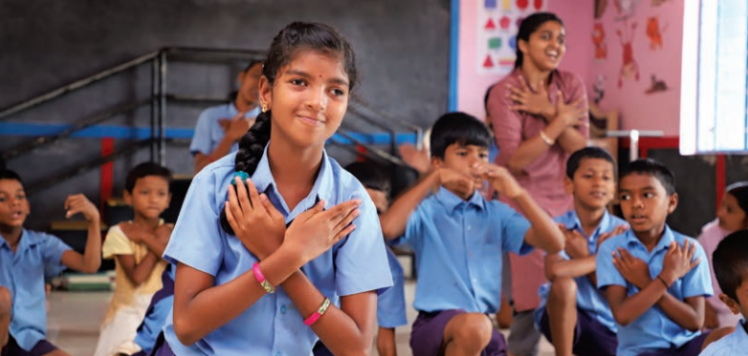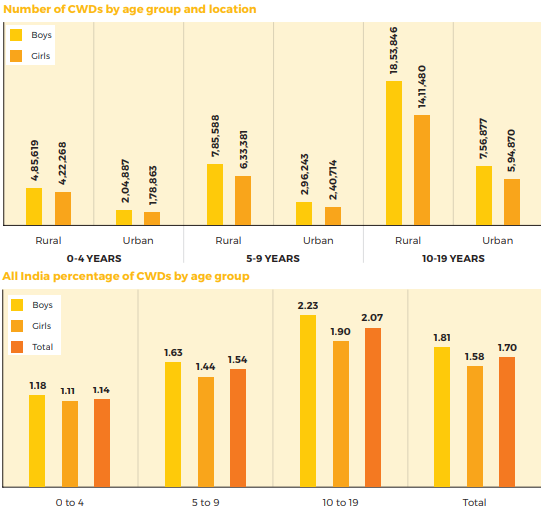Excerpts from the report “State of the Education Report for India 2019 Children with Disabilities”, prepared by the Tata Institute of Social Sciences (Mumbai) and commissioned by UNESCO New Delhi:

The Right to Education (RTE) Act 2009 and the Rights of Persons with Disabilities Act (RPWD) Act 2016 have helped create a comprehensive legal framework for inclusive education. However, there are a few ambiguities about where children with disabilities (CWDs) should study and who should teach them. Gaps remain in the form of appropriate norms and standards applicable to all educational institutions, services provided to CWDs, and the absence of a coordinated authority to enforce the norms and standards.
An analysis of the current situation indicates that an estimated 7.8 million children aged under 19 live with disabilities. National estimates of the proportion of population with disabilities is much lower than international estimates, leading to questions about the disability measures used in the Indian census, as will be discussed later in the report. Among 5 year olds with disabilities, three-fourths do not go to any educational institution. Nor do one-fourth of the CWD population aged between 5 and 19.
The number of children enrolled in school drops significantly with each successive level of schooling. There are fewer girls with disabilities in school than boys. The proportion of children with disabilities who are out of school is much higher than the overall proportion of out-of-school children at the national level. Thus, although the schemes and programmes have brought children with disabilities into schools, gaps remain.

The implementation of the RTE Act 2009 and the RPWD Act 2016 has started with the judiciary playing a key role in interpreting provisions and giving directions to the executive. However, the outcome is mixed due to lack of awareness of legal rights and entitlements of CWDs, lack of accessibility of grievance redressal mechanisms, and lack of a coordinated enforcement mechanism for implementation.
Even though the National Council of Teacher Education (NCTE) and the Rehabilitation Council of India (RCI) are taking measures to prepare teachers for inclusive education, there is a need for continued investment and flexible planning to address emerging issues and gaps in trained human resources.
The attitude of parents and teachers towards including CWDs in mainstream education is crucial to inclusive education. Development of inclusive practices requires flexible curricula and availability of appropriate resources. A variety of frameworks for curriculum design can be employed to develop a curriculum that is both universal and suitable to adaptations.
Accessible physical infrastructure, school processes, assistive technologies, information and communication technology (ICT) and devices are essential. However all these continue to remain challenges, hindering full participation of CWDs. Schoolbased assessment can help gauge the learning needs of diverse children and plan modifications in curriculum and instruction. Lack of assessment in schools can lead to high referrals for specialized assessment of learning disabilities (LDs), and inappropriate formal assessments can lead to inaccurate diagnosis, inflating the incidence of LD.

Early detection of developmental delays and timely intervention in early childhood are not yet widespread, due to infrastructural and capacity limitations at Anganwadis, local bodies responsible for early childhood development. Prevalent data systems require streamlining in order to improve availability, validity and reliability of data.
Governance-related issues such as poor provisioning for education of CWDs across educational settings, the problem of reach, disparities in access, and lack of effective coordination between different stakeholders persist, owing to multiple layers of functioning and the scale of the problem. Inadequate allocations, delays in releasing funds and underutilization of allocations remain key challenges in financing education for CWDs.
The 1989 UN Convention on Rights of the Child (UNCRC) and the 2006 United Nations Convention on the Rights of Persons with Disabilities (UNCRPD) treaty are two international human rights treaties that have a direct bearing on the right to education of CWDs. Although the UNCRC does not specifically mention children with disabilities, the various provisions when read together supply grounds for governments to provide free and compulsory education to all children below 18 years and create education systems that are nondiscriminatory, equitable, accessible to all.
The landmark UNCRPD treaty enunciates the human rights of persons with disabilities, and includes substantive provisions related to education. It is also responsible for bringing inclusive education from a larger social justice perspective to centre stage in international discourses. India has ratified both treaties.

However, India has not signed the Optional Protocol to the UN Convention on Rights of the Child, 2011 and the Optional Protocol to the UN Convention on Rights of Persons with Disabilities, 2006, both of which lay down communication procedures. Hence, monitoring of implementation of treaty provisions happens only through submission of periodic reports to the treaty bodies by the state.
India has made partial progress in harmonizing its national laws with the requirements of UNCRPD. The provisions of the RPWD Act and the amended 2017 Mental Health Care Act (MHCA) are broadly in sync with UNCRPD in the context of education of CWDs. However, both the RTE Act and its amendment in 2012 fall short, as they do not include provisions relating to the core guiding principles of UNCRC (that are reiterated under UNCRPD).
The RTE Act makes no mention of specific educational needs and entitlements of children with disabilities, such as reasonable accommodation and access to assistive technologies, thus further widening the gap with UNCRPD. The National Trust for Welfare of Persons with Autism, Cerebral Palsy, Mental Retardation and Multiple Disabilities Act (NTA), 1999, and the Rehabilitation Council of India (RCI) Act, 1992, are some other legislations that remain to be harmonized with UNCRPD, despite recommendations made by National Human Rights Commission. The Indian Constitution itself does not expressly prohibit discrimination against persons with disability, nor cites it as ground for affirmative action under Article 15, 15 (2).
All state RTE rules, with the exception of Gujarat and Uttarakhand, provide for safe transportation to and from school for children with disabilities. Karnataka and Kerala are the only two states whose RTE rules provide for assistive devices and reasonable accommodation. While most state rules entrust School Management Committees (SMCs) with the identification and enrolment of children with disabilities, and their participation in and completion of elementary education, they do not necessarily specify representation of their parents or guardians or that of the children themselves wherever student participation is provided for. Except Kerala, none of the state rules refer to special schools for children with disabilities in their RTE rules.
In 2016, the Government of India adopted the Rights of Persons with Disabilities Act (RPWD) to bring into effect the provisions of the UNCRPD. The act adopts a human-rights-based approach that replaces the previous medical model. The committee that developed the act comprised government representatives, members from civil society and disabled people’s organisations (DPOs). This was consistent with the spirit of Article 4.3, UNCRPD, and in the Indian context, the first time that persons with disability were called upon to take decisions on matters that directly impacted their lives.
The two main areas of ambiguity:
- Neighbourhood school, special school or home-based education? While the 2012 amendment to the RTE Act requires neighbourhood schools to provide education to CWDs, children with multiple disabilities and severe disabilities also have the right to opt for home-based education. The RPWD Act recognizes the right of a child with benchmark disabilities to education both in the neighbourhood school and a special school of their choice. In other words, all three types of schooling are legally endorsed without any parity in norms and standards between the formats.
- Regular teachers, special teachers, resource teachers or volunteers? While the RTE Act provides only for regular teachers, courts have directed appointment of special educators, and the RCI Act requires appointment of special educators only, to teach children with disabilities.
Two key areas with gaps:
- Absence of a legal framework specifying norms and standards aimed at meeting the specific needs of CWDs that is applicable across neighbourhood school, special school and home-based education formats.
- Absence of a coordinated authority that can enforce the norms and standards across the multiple educational settings where children with disabilities can legally be studying.
At present, the enforcement mechanism under the RTE Act does not extend to special schools, while the enforcement mechanism under the RPWD Act is powerless against schools that do not adhere to its provisions, as the mandate to derecognize schools for noncompliance of norms and standards lies with the education authorities. These ambiguities and gaps severely impinge on the implementation and interpretation of the two legislations.
Courtesy: Counter View